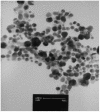Anti-angiogenesis effect of biogenic silver nanoparticles synthesized Using Saliva officinalis on chick chorioalantoic membrane (CAM)
- PMID: 25255752
- PMCID: PMC6271353
- DOI: 10.3390/molecules190913498
Anti-angiogenesis effect of biogenic silver nanoparticles synthesized Using Saliva officinalis on chick chorioalantoic membrane (CAM)
Abstract
Angiogenesis, which is required for physiological events, plays a crucial role in several pathological conditions, such as tumor growth and metastasis. The use of plant extracts is a cost effective and eco-friendly way to synthesize nanoparticles. In the present study, we investigated the anti-angiogenesis properties of silver nanoparticles synthesized using Saliva officinalis extract on chick chorioalantoic membrane. The production of nanoparticles was confirmed by the color change from yellow to brown observed after approximately 3 h at 37 °C. Then, the nanoparticles were characterized by UV-visible spectroscopy, FTIR, and TEM. The UV-visible spectroscopy results showed that the surface plasmon resonance band for AgNPs was around 430 nm. The intensity of the AgNP-specific absorption peak improved with an increase of 0.5 mL of extract into 10 mL of AgNO3 (2.5 mM). The FTIR results showed good interaction between the plant extracts and AgNPs. The TEM images of the samples revealed that the NPs varied in morphology and size from 1 to 40 nm; the average was recorded at 16.5 ± 1.2 nm. Forty Ross fertilized eggs were divided into four groups; the control and three experimental groups. On the 8th day, gelatin sponges containing albumin were placed on the chorioalantoic membrane and soaked with different concentrations of NPs. On the 12th day, all the cases were photographed using a photostereomicroscope. The number and the lengths of the vessels were measured using Image J software. The crown rump (CR) and weight of the embryo were also recorded. Then the hemoglobin content was measured using Drabkin's reagent kit for quantification of the blood vessel formation. According to the data analysis, the number and length of the blood vessels, as well as the CR and weight of the embryos reduced significantly compared to the control (p < 0.05), dose dependently. The total hemoglobin was quantified as an indicator of the blood vessel formation. The hemoglobin content in the treated samples with AgNPs decreased, which showed its inhibitory effect on angiogenesis.
Conflict of interest statement
The authors declare no conflict of interests.
Figures









References
-
- Bhat T.A., Singh R.P. Tumor angiogenesis—a potential target in cancer chemoprevention. Food Chem. Toxicol. 2008;46:1334–1345. - PubMed
-
- Abu-Darwish M.S., Cabral C., Ferreira I.V., Gonçalves M.J., Cavaleiro C., Cruz M.T., Al-bdour T.H., Salgueiro L. Essential oil of common sage (Salvia officinalis L.) from Jordan: Assessment of safety in mammalian cells and its antifungal and anti-inflammatory potential. Biomed Res. Int. 2013;2013:538940. - PMC - PubMed
-
- Xavier C., Lima C., Fernandes-Ferreira M., Pereira-Wilson C. Salvia fruticosa, Salvia officinalis, and rosmarinic acid induce apoptosis and inhibit proliferation of human colorectal cell lines: The role in MAPK/ERK pathway. Nutr. Cancer. 2009;61:564–571. doi: 10.1080/01635580802710733. - DOI - PubMed
-
- Khalil W.K.B., Abdu F., Biology C. Effects of Salvia officinalis extract and its nano-encapsulated form on methylmercury induced neurotoxic-stress in male rats department of biological science, faculty of science. World Appl. Sci. J. 2013;24:826–837.
Publication types
MeSH terms
Substances
LinkOut - more resources
Full Text Sources
Other Literature Sources

